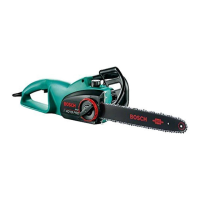18
EURO • Printed in Germany • BA F 016 L69 742 • AKE 3000/3500/4000/AKE 30/35/40-17 S • GB • OSW 09/00
F 016 L69 742 • TMS • 09.00
Before Cutting
Before and periodically during cutting check as follows:
– Is the general condition of chain saw in order?
– Is the oil reservoir filled? Check oil level gauge 28
prior to starting and regularly during operation. Refill
oil when oil level is low. The oil tank filling will last ap-
prox. 15 minutes, depending on sawing intensity and
stops.
– Is the chain tension in order and is the chain sharp?
Check chain tension every 10 minutes during opera-
tion. Upon initial operation, new chains can lengthen
considerably.
– Is the kick back brake deactivated and its function en-
sured?
– Are you wearing the necessary protective equip-
ment?
Kick back
Kick back is the sudden backward/upward motion of the
chain saw, occuring when the chain (at the tip of the
chain bar) comes in contact with a log or wood, or when
the chain becomes jammed.
Kick back can lead to potentially dangerous situations or
injuries to the chain saw operator or bystanders.
Particular attention must be given when sawing horizon-
tally, slanted or during length cuts, as the gripping
teeth 12 usually can not be applied.
To avoid kick back:
– Saw with the chain bar at a flat angle.
– Never saw with a loose or worn out chain.
– Ensure chain is sharpened correctly.
– Never saw above shoulder height.
– Never saw with the leading edge or tip of the chain.
– Alway hold a chain saw firmly with two hands.
– Always use a Bosch low kick back chain.
– Apply the metal gripping teeth 12 for leverage.
– Ensure correct chain tension.
General
Always hold the chain saw firmly with both hands.
Front grip with the left hand and rear grip with the right
hand. Fully grip both handles at all times during opera-
tion. Never operate chain saw using only one hand. En-
sure power cord is located to the rear, away from the
chain and wood.
Use the chain saw only with secure footing. Hold the
chain saw at the right hand side of your body.
The chain must be running before it makes contact
with the wood. Use the metal gripping teeth 12 to secure
the saw onto the wood, before starting to cut. Use the
gripping teeth as a leverage point “X” while cutting.
Reset the gripping teeth at a lower point when sawing
thicker logs by pulling the chain saw slightly backwards,
until the gripping teeth release, and reposition at lower
level to continue sawing. Do not remove the saw com-
pletely from the wood.
Do not force the chain while cutting, let the chain do the
work, using the gripping teeth 12 to apply minimal lever-
age pressure.
Do not operate the chain saw with arms fully ex-
tended or attempt to saw areas which are difficult to
reach, or on a ladder. Never use the chain saw above
shoulder height.
Sawing is optimized when the chain speed remains
steady during cutting.
Beware when reaching the end of the cut. The weight of
the saw may change unexpectedly as it cuts free from
the wood. Accidents can occur to the legs and feet.
Always remove the saw from a wood cut while the saw
is running.
Cutting Logs
Observe the following safety instructions:
Support logs so that the face sides at the cut do
not close in against each other, which would result in the
chain being jammed.
Position and set short logs safely prior to sawing.
Saw only wood or wooden objects. When sawing, al-
ways take care to avoid hitting stones, nails, etc., as
these could be thrown up or cause damage to the chain.
When running keep the saw it clear of wire fencing or the
ground.
Use of the saw to thin out branches or bushes is not ap-
proved.
Length cuts must be carried out with care, as leverage
with the gripping teeth 12 is not possible. Saw at a flat
angle to avoid kick back.
When working on a slope, operate above or to the side
of the trunk or laying tree.
Be careful not to trip over tree stumps, branches, roots,
etc.
Cutting wood under tension
Trapped branches, trees or wood can react unexpect-
edly when released from tension by sawing, resulting in
injuries or even death. Be extremely careful. Leave sa-
wing jobs like these to professionals.
When sawing logs supported on both ends, start the cut
from above (Y) about 1/3 into the log and then finish the
cut (Z) from below, in order to avoid splitting of the log or
jamming of the saw. Avoid contact of the chain saw with
the ground. When sawing logs supported on only one
end, start the cut from below (Y) about 1/3 into the log
and finish the cut from above (Z), in order to avoid log
splitting or jamming of the chain saw.
Cutting
E
E
F
G
H
F I
I
AKE 3000/3500/4000 - Buch Seite 18 Dienstag, 9. Oktober 2001 11:49 11

